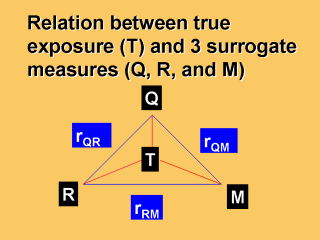| front |1 |2 |3 |4 |5 |6 |7 |8 |9 |10 |11 |12 |review |
 |
In the diagram on the left side, the 3
measures of exposure are represented by the 3 corners of the triangle, hence the name “method
of triads” and each of the surrogate measures is hypothesized to be linearly
related to the true exposure (T). Also, pair-wise Pearson correlations between
the 3 methods can be computed and are abbreviated as rQR, rQM and
rRM. The correlation between T and each of the surrogate methods (Q or R or M) is referred to as the validity coefficient (VC). If all the 3 methods were relatively valid we would expect the correlations (VC) between each of the methods (Q, R, and M) and the true exposure to be about equal. This is the basis for the use of VCs in validating exposure measurements. Use of the VC instead of a simple correlation is of advantage because the VC reduces the likelihood of over/underestimation of the true correlation, if two of the surrogate methods were correlated or if repeated measurements from any of the methods were correlated. |